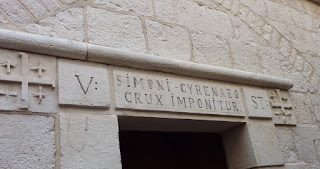
Jerusalem means "founded by Shalom:...the writer of Hebrews (7:2) interpreted the Salem to mean "peace" because it sounded like SHALOM. Jerusalem has also been called the City of David, Mt. Moriah, and Zion. The history of Jerusalem can be followed through the Biblical references from Genesis to Revelation. Jerusalem, the Holy City, is important for people of three faiths: Judaism, Christianity, and Islam. The Old City is walled with Gates leading into the various sections of the Old City.
Via Dolorosa, “The Way of Sorrow.” Is the traditional pathway Jesus took from the “hall of judgment” to Calvary. The “way of the cross” winds along the narrow streets of the Old City, leading from the first station at Echo Homo Covenay to the Church of the Holy Sepulchre. Along this route are 14 stations of the cross…each one marking a special event along the way as Jesus carried the Cross.

1. Jesus is condemned by Pontius Pilate.
2. Jesus receives his Cross.
3. Jesus falls under the weight of the Cross.
4. Jesus meets his mother.
5. Simon of Cyrene helps Jesus to carry the Cross.
6. Veronica wipes the face of Jesus.
7. Jesus falls a second time.
8. Jesus speaks to the daughters of Jerusalem.
9. Jesus falls a third time.
10. Jesus is stripped of his garments.
11. Jesus is nailed to the Cross.
12. Jesus dies on the Cross.
13. Jesus is taken down from the Cross.
14. Jesus is laid in the tomb.




At the end of the Via Dolorosa is an anointing stone. Tradition indicates this is where Jesus' body was prepared for burial. Many people were at this stone, including a young couple with a child that looked to be a new born. Some people placed rosaries, pictures, other memorabilia on the stone and rubbed the item(s) back and forth. Touching the stone was smooth to the touch from anointing oil. Some people would lean over and kiss the stone, others knelt down, touched the stone and were overcome with emotion.
The stories told were John 18:28-38a (Jesus before Pilate) and John 18:38b-19:3-11(Jesus is sentenced to death).
While I found retracing the steps of the "way of the cross" interesting, I can't say I was moved a lot. Perhaps as we enter Lent and Good Friday my experience will become more meaningful.
Due to the Greek Orthodox and Roman Catholic influences some of the sites are quite ornate. The next picture is the site where some believe the crucifixion cross stood. Here one can stoop down and place your hand in a hole that is supposedly where the cross was raised.

Along the way were lots of shops. Everyone wants to sell you something. If you make eye contact the item before you is considered to be sold and some of the vendors can become persistent. Most are nice and understand NO but will try to get you to make a purchase.


See something you want to purchase? It's time to bargain. Think the price is still too high. walk away. Chances are you will be pursued and will be able to negotiate a reasonable price. I suppose it's like purchasing a car.
It's likely that vendors would have been present as Jesus walked by carrying the cross. They can be distracting and can interfere with the meaning of the moment.
Some information about Antonia follows, In 35 B.C. King Herod rebuilt the Baris, a strong fortress to protect the Temple Mount. It was located on the Northwest corner of the Temple Mount and called the Fortress of Antonia, named after Herod’s friend Marc Antony and another of Herod's landmarks. It stood 115 feet high and was partly surrounded by a deep ravine 165 feet wide. It functioned as headquarters for the Roman soldiers, a palace and a barracks. Herod constructed a secret passage from the fortress to the Temple.
While overlooking Jerusalem, the Antonia Fortress was garrisoned with 600 Roman soldiers, who watched over the Temple courts in order to preserve order. The Bible spoke about the Antonia Fortress as a barracks (Acts 21:37), and it was here that Paul gave an address to the people (22:1-21).
Acts 21:32-36
33 Then the commander came near and took him, and commanded him to be bound with two chains; and he asked who he was and what he had done.
34 And some among the multitude cried one thing and some another. So when he could not ascertain the truth because of the tumult, he commanded him to be taken into the barracks.
35 When he reached the stairs, he had to be carried by the soldiers because of the violence of the mob.
36 For the multitude of the people followed after, crying out," Away with him!"
It is believed that it was here at the Antonia Fortress where Pontius Pilate judged Jesus, but it there is also a possibility that Jesus was judged at the Herodian fortress on the opposite end of the city. Herod's palace was the official residence of the Roman procurator's when they came to Jerusalem during the major Jewish festivals.


We stopped along the way and had pizza for lunch at a very nice gift shop that is owned by our guide's family. They closed the shop to the public and gave us a great discount on items purchased. It wasn't until later on the trip I realized what a bargain we were offered. I did purchase a couple of gifts and a silver Jerusalem cross and silver chain for myself. I now wish I had made some other purchases. Oh well, guess I will just have to go back.
Later we went to the Upper Room which is situated over King David's tomb. I will write more about this in the next entry.

No comments:
Post a Comment